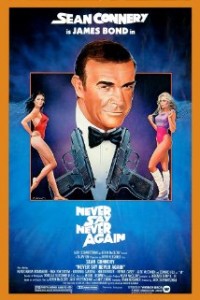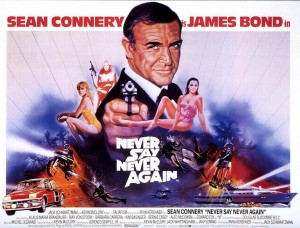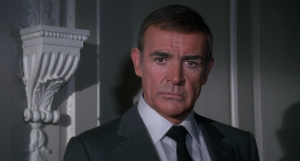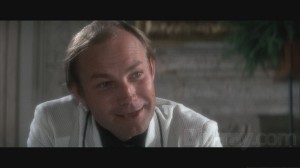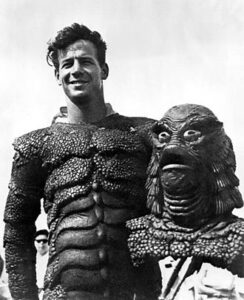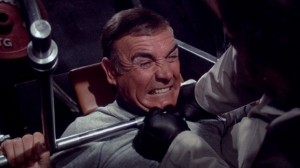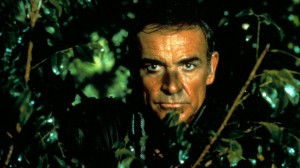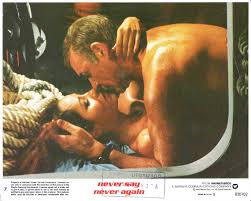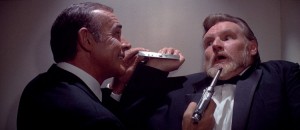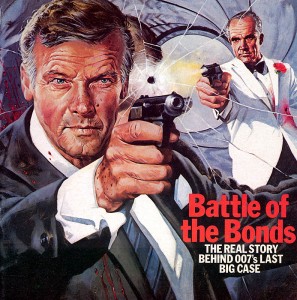Never Say Never Again *** (1983, Sean Connery, Kim Basinger, Klaus Maria Brandauer, Barbara Carrera, Bernie Casey, Alec McCowen, Edward Fox) – Classic Movie Review 990
Director Irving Kershner’s 1983 007 spy movie Never Say Never Again stars a fit-looking 52-year-old Sean Connery, who confidently returns for a one-off grab at his James Bond crown in a remake of the 1965 Thunderball with a title his wife Micheline provided (he had said he’d never do another Bond movie, and she said Never Say Never Again). It’s an unofficial, non-Eon Productions Bond movie, one of only two, along with the original Casino Royale in 1967.
Connery is playing 007 for the seventh and final time, and returning to Bond 12 years after Diamonds Are Forever. Filming locations include France, Spain and the Bahamas, as well as Elstree Studios in the UK. The film is based on the 1961 James Bond novel Thunderball by Ian Fleming, which was based on an original story by Kevin McClory, Jack Whittingham and Fleming.
Connery’s fine, confident final appearance as Bond apart, it gains enormously from the heavyweight appearances from super-villains Klaus Maria Brandauer (as Maximillian Largo) and Max von Sydow (as Ernst Stavro Blofeld), a good villainess in Barbara Carrera (as Fatima Blush!), and strong casting as M (Edward Fox) and Q (Alec McCowen), both of them excellent.
Less thrilling are Kim Basinger as Domino Petachi, Bernie Casey as Felix Leiter, Pamela Salem as Miss Moneypenny, Rowan Atkinson (in his first movie) as Nigel Small-Fawcett, none of them particularly well cast.
The movie is around average for the course for a Bond movie of the era, with the mixture served up just as always. And there are plenty of the required gadgets, stunts and action. It was released on 7 October 1983 in the US, just four months after the official Roger Moore-led Octopussy (released on 10 June 1983 in the US), which is about the same mixture and achievement more or less. It’s instructive to compare it with Octopussy and Thunderball as well as Connery’s previous Bond movie, Diamonds Are Forever.
Lorenzo Semple Jnr’s screenplay is a good one, sharp and literate. The comedy writing team of Dick Clement and Ian La Frenais also worked uncredited on the writing, livening up the dialogue. In their script, based on the original Thunderball story by Ian Fleming, Kevin McClory and Jack Whittingham, Blofeld’s SPECTRE agents infiltrate a US air force base in the UK and steal two Tomahawk cruise missiles. When NATO is held to ransom, James Bond is sent to recapture the warheads and kill Blofeld.
It’s true that director Irving Kershner (who directed Connery back in 1966 on A Fine Madness) brings little of the extra special flair for action adventure that he showed in his brilliant Star Wars movie The Empire Strikes Back, though he’s very much better with the dialogue scenes and the actors. And, in the final analysis, the film comes out as smooth, polished entertainment.
But Never Say Never Again and Connery ended up losing the much discussed Bond vs Bond showdown. In 1985 Variety listed Octopussy‘s US gross at $67.9 million and Never Say Never Again’s at $55.4 million, with Octopussy’s worldwide gross at $187.5 million and Never Say Never Again’s at $160 million. Octopussy had $34.031 million in US rentals, while Never Say Never Again had $28.2 million.
Fleming had worked with independent producer Kevin McClory and scriptwriter Jack Whittingham on a screenplay for a potential Bond film called Longitude 78 West, which was abandoned because of costs. Fleming turned this into the novel Thunderball but did not credit either McClory or Whittingham. McClory then took Fleming to the High Court in London for breach of copyright and the matter was settled in 1963.
McClory, who was producer and co-writer of Thunderball, won a legal battle against Ian Fleming’s trustees to make his own Bond movie, and the settlement stipulated that it had to effectively be a remake of Thunderball. A lawsuit with Eon Productions ended in a ruling that McClory owned the sole rights to SPECTRE and Blofeld, forcing Eon to remove them from The Spy Who Loved Me (1977).
A young Steven Seagal was the martial arts instructor for this film and broke Connery’s wrist during training.
Domino Petachi is based on Dominique Derval, nicknamed Domino, in Thunderball, Fatima Blush is based on Fiona Volpe in Thunderball and Maximillian Largo is based on Emilio Largo in Thunderball.
Claudine Auger, Adolfo Celi and Luciana Paluzzi played Domino, Emilio Largo and Fiona Volpe in the original Thunderball movie.
A final attempt by Fleming’s trustees to block the film was made in the High Court in London in Spring 1983, but it was thrown out of court and the film was permitted to proceed.
SPECTRE = Special Executive for Counter-intelligence, Terrorism, Revenge and Extortion. It’s now also the title of the 2015 Bond movie Spectre.
Astoundingly, the producers acknowledged Micheline Roquebrune’s contribution to the film by listing on the end credits: ‘Title “Never Say Never Again” by: Micheline Connery’.
Michel Legrand’s much disliked score is similar to his work as a jazz pianist. He also writes the main theme, with lyrics by Alan and Marilyn Bergman, performed by Lani Hall.
Ricou Browning directed the underwater sequences in Eon Productions’ 1965 fourth James Bond movie Thunderball, as well as for Never Say Never Again.
Connery’s pay was $5 million plus 5 per cent of the net US profits, which equals $6,410,000 in total.
Sean Connery’s last word on 007: ‘I have always hated that damn James Bond. I’d like to kill him.’
The cast are Sean Connery as James Bond, Klaus Maria Brandauer as Maximillian Largo, Max von Sydow as Ernst Stavro Blofeld, Barbara Carrera as Fatima Blush, Kim Basinger as Domino Petachi, Bernie Casey as Felix Leiter, Alec McCowen as Q, Edward Fox as M, Pamela Salem as Miss Moneypenny, Rowan Atkinson as Nigel Small-Fawcett, Valerie Leon as Lady in Bahamas, Milow Kirek as Dr Kovacs, Pat Roach as Lippe, Anthony Sharp as Lord Ambrose, Prunella Gee as Nurse Patricia Fearing, and Gavan O’Herlihy as Captain Jack Petachi.
Ricou Browning also co-created the 1963 film Flipper with Jack Cowden, and directed a number of episodes of the 1960s TV series. He directed the underwater sequences in the comedy films Hello Down There (1969) and Caddyshack (1980).
But he is best known for his underwater stunt work, especially in the 1954 film Creature from the Black Lagoon, in which he plays the Gill Man in the underwater scenes. He reprised the role for the underwater scenes in the sequels Revenge of the Creature (1955) and The Creature Walks Among Us (1956).
Ricou Browning died at his home in Southwest Ranches, Florida, on 27 February 2023, aged 93. He was the last surviving original actor to portray any of the Universal classic monsters.
http://derekwinnert.com/thunderball-classic-film-review-410/
http://derekwinnert.com/octopussy-classic-film-review-698/
http://derekwinnert.com/diamonds-are-forever-1971-sean-connery-classic-film-review-953/
© Derek Winnert 2014 Classic Movie Review 990
Check out more reviews on http://derekwinnert.com/

